Yes, VCDS (VAG-COM Diagnostic System) can perform headlight range control basic settings, especially for Xenon and LED headlight adaptation. At CAR-SCAN-TOOL.EDU.VN, we offer comprehensive training to help you master VCDS and other car scan tools, unlocking their full potential for accurate diagnostics and efficient repairs. Our expert-led, remote technician education ensures you gain the skills needed to excel in automotive diagnostics, including advanced procedures like headlight adaptation and remote technician education.
Contents
- 1. Understanding Headlight Range Control
- 2. Why Use VCDS for Headlight Adaptation?
- 3. When Do You Need to Perform Headlight Range Control Basic Settings?
- 4. Step-by-Step Guide: Performing Headlight Range Control Basic Settings with VCDS
- 5. Common Issues and Troubleshooting
- 6. Benefits of Professional Training in VCDS and Automotive Diagnostics
- 7. Why Choose CAR-SCAN-TOOL.EDU.VN for Your Automotive Training?
- 8. Advanced VCDS Functions for Headlight Control
- 9. Real-World Examples and Case Studies
- 10. Maintaining and Calibrating Headlights: Best Practices
- 11. Headlight Technology: Xenon vs. LED
- 12. Legal and Safety Standards for Headlight Alignment
- 13. Future Trends in Automotive Lighting and Diagnostics
- 14. Frequently Asked Questions (FAQ)
- 15. Call to Action
Table of Contents
- Understanding Headlight Range Control
- Why Use VCDS for Headlight Adaptation?
- When Do You Need to Perform Headlight Range Control Basic Settings?
- Step-by-Step Guide: Performing Headlight Range Control Basic Settings with VCDS
- Common Issues and Troubleshooting
- Benefits of Professional Training in VCDS and Automotive Diagnostics
- Why Choose CAR-SCAN-TOOL.EDU.VN for Your Automotive Training?
- Advanced VCDS Functions for Headlight Control
- Real-World Examples and Case Studies
- Maintaining and Calibrating Headlights: Best Practices
- Headlight Technology: Xenon vs. LED
- Legal and Safety Standards for Headlight Alignment
- Future Trends in Automotive Lighting and Diagnostics
- Frequently Asked Questions (FAQ)
- Call to Action
1. Understanding Headlight Range Control
Headlight range control is a crucial safety feature in modern vehicles, especially those equipped with Xenon or LED headlights. This system automatically adjusts the vertical angle of the headlights to ensure optimal illumination of the road without blinding oncoming traffic. The primary goal is to maintain consistent visibility regardless of vehicle load, acceleration, or braking.
- Functionality: The system uses sensors on the vehicle’s suspension to detect changes in ride height. This data is then fed into a control module that adjusts the headlight angle via small motors.
- Importance: Proper headlight alignment is vital for safe driving, particularly at night. Misaligned headlights can significantly reduce visibility and pose a risk to other drivers.
- Adaptive Headlights: Many modern vehicles also feature adaptive headlights that can adjust horizontally to illuminate curves and intersections, further enhancing safety.
2. Why Use VCDS for Headlight Adaptation?
VCDS is a powerful diagnostic tool widely used for Volkswagen, Audi, Skoda, and SEAT vehicles. It offers a range of functions beyond basic code reading, including the ability to perform advanced adaptations and calibrations like headlight range control basic settings.
- Comprehensive Control: VCDS allows you to directly access and modify the control module responsible for headlight range adjustment.
- Accuracy: Unlike manual adjustments, VCDS ensures precise calibration based on the vehicle’s actual parameters.
- Error Detection: VCDS can identify and clear fault codes related to the headlight range control system, helping you diagnose underlying issues.
- Customization: VCDS enables you to fine-tune headlight settings to match your specific preferences and driving conditions.
- Cost-Effective: While VCDS requires an initial investment, it can save you money in the long run by allowing you to perform these adjustments yourself, avoiding costly trips to the dealership.
3. When Do You Need to Perform Headlight Range Control Basic Settings?
There are several scenarios where performing headlight range control basic settings with VCDS becomes necessary.
- Headlight Replacement: Whenever you replace a headlight, especially a Xenon or LED unit, you need to recalibrate the system to ensure proper alignment.
- Suspension Work: Any adjustments or repairs to the vehicle’s suspension can affect the headlight range control system and require recalibration.
- Ride Height Changes: Lowering or lifting your vehicle’s suspension will necessitate adjusting the headlight range to compensate for the altered ride height.
- Fault Codes: If you encounter fault codes related to headlight range control, performing basic settings can often resolve the issue.
- Poor Visibility: If you notice that your headlights are not properly illuminating the road or are blinding other drivers, recalibration may be necessary.
- Ballast Replacement: If the ballast is faulty, these steps are required after replacement.
4. Step-by-Step Guide: Performing Headlight Range Control Basic Settings with VCDS
Here’s a detailed guide on how to perform headlight range control basic settings using VCDS. This process ensures that your headlights are correctly aligned and functioning optimally.
Tools and Requirements:
- VCDS Software and Interface Cable
- Laptop with Windows OS
- Flat, level surface
- Measuring tape
- Phillips head screwdriver (for minor mechanical adjustments)
Step 1: Preparation
- Park the Vehicle: Park your car on a level surface approximately 20 feet (6 meters) away from a flat wall.
- Measure Headlight Height: Measure the distance from the ground to the center of your headlight lens. Transfer this measurement to the wall. This will serve as your reference point.
- Connect VCDS: Plug the VCDS interface cable into your laptop and the OBD-II port in your vehicle.
- Turn on Ignition: Turn on the vehicle’s ignition, but do not start the engine.
Step 2: Accessing the Headlight Range Control Module
-
Open VCDS: Launch the VCDS software on your laptop.
-
Select Control Module: Click on “Select” to access the control module selection screen.
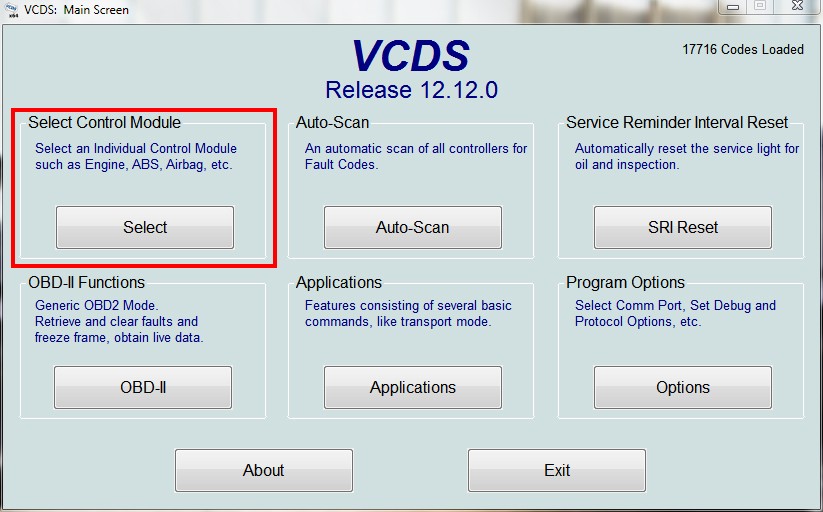 Select Control Module VCDS
Select Control Module VCDS -
Choose Xenon Range: Locate and select “55 – Xenon Range” (or “Headlight Range Control”).
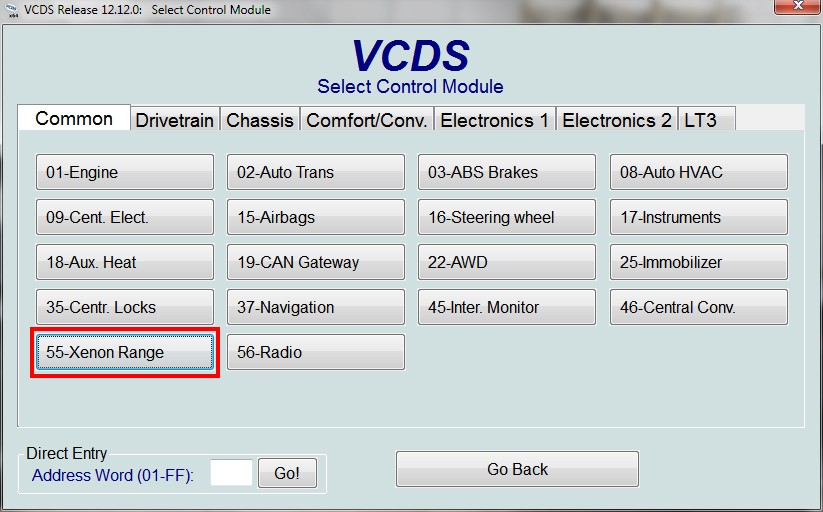 Select Xenon Range VCDS
Select Xenon Range VCDS
Step 3: Resetting to Factory Adaptation
-
Adaptation – 10: Click on the “Adaptation – 10” button in the “Advanced Functions” section.
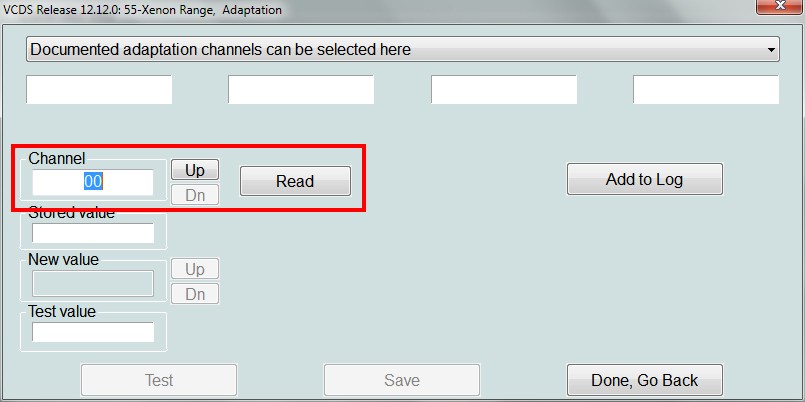 Adaptation 10 VCDS
Adaptation 10 VCDS -
Channel 00: Enter “00” in the “Channel Number” box and click “Read”. This will load the factory default settings.
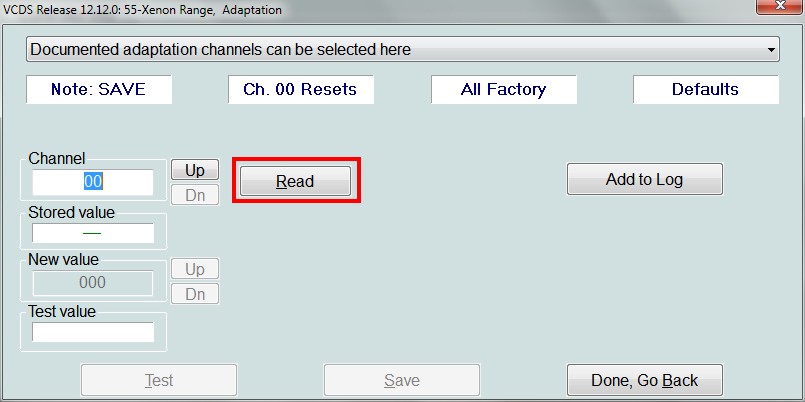 Channel 00 Read VCDS
Channel 00 Read VCDS -
Save: Click “Save” to apply the reset. A popup box will ask you to confirm. Click “Yes” to proceed.
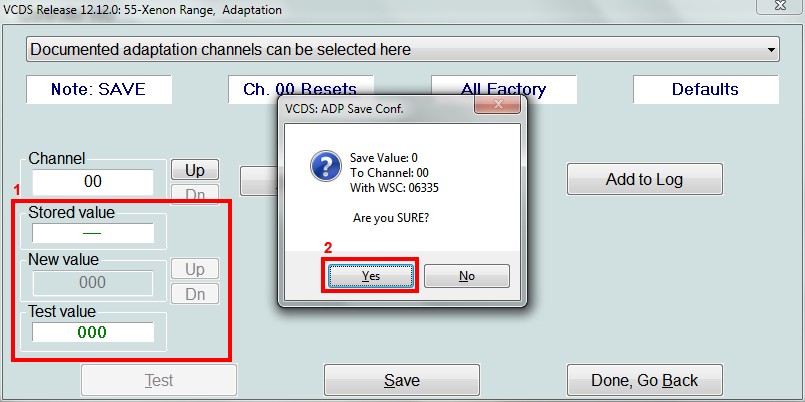 Save Reset VCDS
Save Reset VCDS
Step 4: Setting Adjustment via Basic Settings
-
Basic Settings – 04: Click on the “Basic Settings – 04” button.
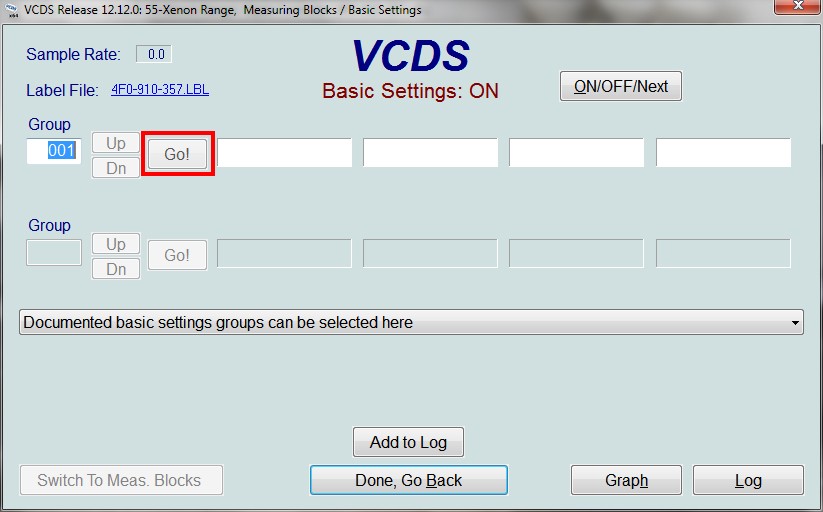 Basic Settings 04 VCDS
Basic Settings 04 VCDS -
Channel 01: Ensure you are on Channel 01. If the “Go!” button is not enabled, switch to another channel and then return to Channel 01.
-
Go!: Click the “Go!” button to start the basic settings process. The system will now begin to adjust the headlights.
-
Wait: Observe the output boxes to the right. Wait for approximately 20 seconds after the display changes.
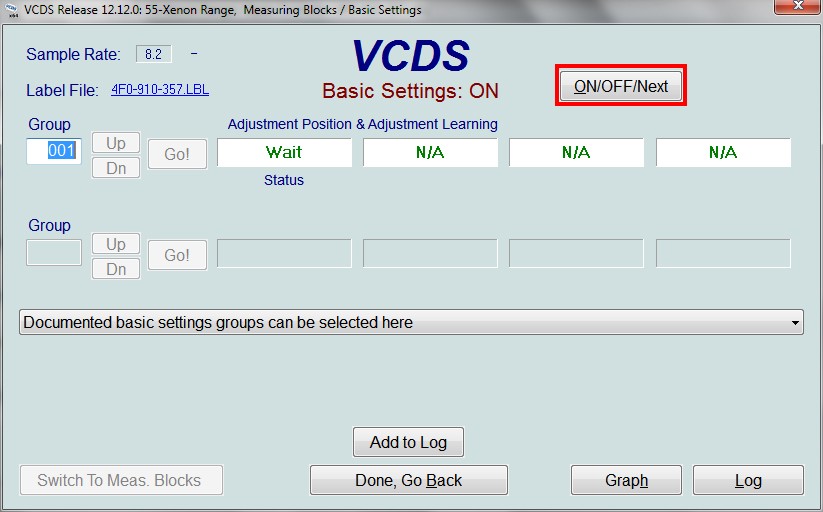 Output Boxes VCDS
Output Boxes VCDS
Step 5: Fine-Tuning and Learning
-
On/Off/Next: Click the “On/Off/Next” button to continue to the learning state. The output boxes will display “ADJUST” and/or “LEARNING”.
-
Manual Adjustment: At this point, manually adjust your headlights using a Phillips head screwdriver, if necessary. Refer to the adjustment screws on the headlight assembly.
- Clockwise = Up
- Counterclockwise = Down
-
Wait: If no adjustment is needed, wait 20-30 seconds in the “LEARNING” state to allow the module to learn the current position.
-
On/Off/Next: Click the “On/Off/Next” button again. The output boxes should now indicate that the adjustment has been successfully set.
 Adjustment Set VCDS
Adjustment Set VCDS
Step 6: Verification and Completion
-
Check Fault Codes: Return to the main Xenon Range screen and check for any fault codes. If the adjustment was successful, there should be no new fault codes.
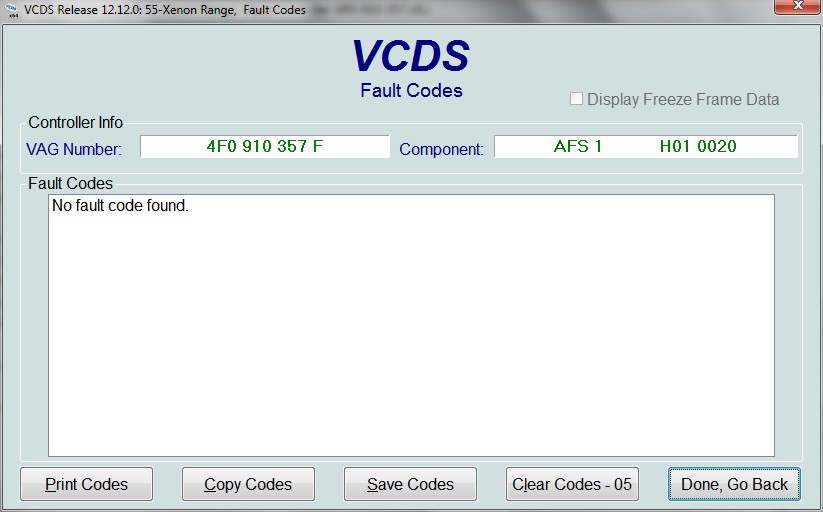 No Fault Codes VCDS
No Fault Codes VCDS -
Test Headlights: Turn on your headlights and verify that they are properly aligned by observing the beam pattern on the wall. The brightest part of the beam should be at or slightly below the reference point you marked earlier.
Important Considerations:
- Level Surface: Ensure that your vehicle is parked on a perfectly level surface to achieve accurate results.
- Battery Voltage: Maintain a stable battery voltage during the process to prevent errors. Consider using a battery charger or maintainer.
- Patience: Allow the system enough time to complete each step. Rushing the process can lead to incorrect settings.
- Safety: Always prioritize safety when working on your vehicle. Wear appropriate personal protective equipment (PPE) and follow all safety guidelines.
By following these steps carefully, you can effectively perform headlight range control basic settings using VCDS, ensuring optimal visibility and safety while driving.
5. Common Issues and Troubleshooting
While VCDS makes headlight adaptation relatively straightforward, you may encounter some common issues. Here’s how to troubleshoot them:
- “Dipped Headlight” Fault: This usually indicates that the adaptation or adjustment has not been set correctly. Repeat the basic settings procedure to resolve this.
- “Go!” Button Not Enabled: Try switching to another channel and then back to Channel 01 to enable the “Go!” button.
- Incorrect Beam Pattern: If the beam pattern is still not correct after performing basic settings, double-check your manual adjustments and repeat the procedure.
- Fault Codes Persist: If fault codes persist after recalibration, there may be an underlying issue with the headlight range control system, such as a faulty sensor or motor. Further diagnosis may be required.
- VCDS Not Connecting: Ensure that your VCDS interface cable is properly connected to both your laptop and the vehicle’s OBD-II port. Also, verify that you have the latest version of the VCDS software installed.
6. Benefits of Professional Training in VCDS and Automotive Diagnostics
While guides like this can help you perform basic tasks, professional training in VCDS and automotive diagnostics offers numerous benefits:
- In-Depth Knowledge: Training provides a deeper understanding of the underlying systems and how they interact.
- Advanced Techniques: You’ll learn advanced diagnostic techniques and troubleshooting strategies that go beyond basic procedures.
- Hands-On Experience: Many training programs offer hands-on experience with real vehicles, allowing you to apply what you’ve learned in a practical setting.
- Certification: Completing a certified training program can enhance your credentials and demonstrate your expertise to employers and customers.
- Career Advancement: Investing in training can open up new career opportunities and increase your earning potential.
- Up-to-date Knowledge: The automotive industry is constantly evolving, so training ensures you stay current with the latest technologies and diagnostic methods. According to a study by the National Institute for Automotive Service Excellence (ASE), technicians who undergo regular training are more likely to provide accurate diagnoses and efficient repairs, leading to higher customer satisfaction and increased profitability for their employers.
7. Why Choose CAR-SCAN-TOOL.EDU.VN for Your Automotive Training?
At CAR-SCAN-TOOL.EDU.VN, we’re dedicated to providing high-quality, accessible automotive training to technicians of all skill levels. Our remote technician education programs are designed to equip you with the knowledge and skills you need to excel in today’s competitive automotive industry.
- Expert Instructors: Our courses are taught by experienced automotive professionals with extensive knowledge of VCDS and other diagnostic tools.
- Comprehensive Curriculum: We offer a comprehensive curriculum covering a wide range of topics, from basic diagnostics to advanced troubleshooting techniques.
- Flexible Learning: Our online courses allow you to learn at your own pace and on your own schedule, making it easy to fit training into your busy life.
- Hands-On Simulations: Our courses incorporate hands-on simulations and virtual labs to provide you with practical experience.
- Certification: Upon completion of our programs, you’ll receive a certification that validates your skills and knowledge.
- Career Support: We provide career support services to help you find employment opportunities and advance your career.
- Affordable Pricing: We offer competitive pricing and flexible payment options to make our training accessible to everyone.
- Cutting-Edge Content: We continuously update our course content to reflect the latest advancements in automotive technology.
Our training programs at CAR-SCAN-TOOL.EDU.VN focus on the following core areas:
- VCDS Diagnostics: Master the use of VCDS for comprehensive vehicle diagnostics, coding, and adaptation.
- Scan Tool Proficiency: Learn to effectively use various scan tools to diagnose and repair complex automotive issues.
- Data Analysis: Develop the ability to interpret and analyze scan tool data to identify root causes of problems.
- Remote Diagnostics: Gain skills in performing remote diagnostics, enabling you to assist customers and technicians from a distance.
By choosing CAR-SCAN-TOOL.EDU.VN, you’re investing in your future and positioning yourself for success in the dynamic world of automotive technology.
8. Advanced VCDS Functions for Headlight Control
Beyond basic settings, VCDS offers several advanced functions for fine-tuning headlight control:
- Coding: You can modify the coding of the headlight control module to enable or disable certain features, such as cornering lights or daytime running lights.
- Adaptation Channels: VCDS allows you to access and modify various adaptation channels within the headlight control module, enabling you to customize parameters such as the sensitivity of the headlight range control system.
- Output Tests: You can use VCDS to perform output tests on the headlight motors to verify their functionality and diagnose any mechanical issues.
- Data Logging: VCDS enables you to log data from the headlight range control system in real-time, allowing you to monitor its performance under different driving conditions.
9. Real-World Examples and Case Studies
To illustrate the benefits of VCDS and professional training, consider these real-world examples:
- Case Study 1: Headlight Malfunction After Suspension Upgrade: A technician encountered a vehicle with malfunctioning headlights after the owner installed a lowering kit. Using VCDS, the technician was able to recalibrate the headlight range control system and restore proper headlight function.
- Case Study 2: Diagnosing Intermittent Headlight Issues: A vehicle exhibited intermittent headlight issues, with the headlights occasionally pointing too high or too low. By using VCDS to log data from the headlight range control system, a trained technician identified a faulty sensor and replaced it, resolving the problem.
- Case Study 3: Customizing Headlight Behavior: A vehicle owner wanted to customize the behavior of their headlights, enabling cornering lights and adjusting the sensitivity of the headlight range control system. With VCDS and the guidance of a trained professional, they were able to achieve their desired settings.
These examples demonstrate the power of VCDS and the importance of having the knowledge and skills to use it effectively.
10. Maintaining and Calibrating Headlights: Best Practices
To ensure optimal headlight performance and longevity, follow these best practices:
- Regular Inspections: Periodically inspect your headlights for damage, such as cracks or broken lenses.
- Clean Lenses: Clean your headlight lenses regularly to remove dirt and debris that can reduce light output.
- Check Alignment: Have your headlight alignment checked periodically, especially after suspension work or if you notice any issues with visibility.
- Use Quality Bulbs: Use high-quality replacement bulbs that meet or exceed OEM specifications.
- Professional Calibration: Consider having your headlights professionally calibrated by a trained technician using VCDS or other specialized equipment.
11. Headlight Technology: Xenon vs. LED
Xenon and LED headlights are two popular types of modern automotive lighting, each with its own advantages and disadvantages:
| Feature | Xenon | LED |
|---|---|---|
| Brightness | High | High |
| Energy Efficiency | Moderate | High |
| Lifespan | Long (2,000-3,000 hours) | Very Long (15,000+ hours) |
| Color Temperature | Typically bluish-white | Customizable |
| Cost | Moderate | High |
| Complexity | Requires ballast and starter | Simpler design, no ballast needed |
| Heat Generation | Generates significant heat | Generates less heat |
| Adaptability | Well-suited for adaptive headlight systems | Excellent for adaptive headlight systems, allowing for more precise control |
- Xenon Headlights: Xenon headlights produce light by passing an electric arc through Xenon gas. They offer high brightness and a distinctive bluish-white color.
- LED Headlights: LED (Light Emitting Diode) headlights use semiconductor diodes to produce light. They are highly energy-efficient, have a very long lifespan, and offer customizable color temperatures.
Both Xenon and LED headlights require proper range control to ensure optimal visibility and avoid blinding other drivers.
12. Legal and Safety Standards for Headlight Alignment
Headlight alignment is subject to legal and safety standards to ensure that vehicles on the road provide adequate illumination without posing a hazard to other drivers. These standards vary by region and country, but generally specify:
- Minimum and Maximum Height: Headlights must be mounted within a certain height range above the ground.
- Beam Pattern: The beam pattern must conform to specific requirements to ensure proper illumination of the road ahead without excessive glare.
- Aiming Angle: Headlights must be aimed at a specific angle to ensure that the beam is properly directed.
It’s essential to be aware of and comply with these standards when adjusting or calibrating your headlights.
13. Future Trends in Automotive Lighting and Diagnostics
The automotive lighting and diagnostics industries are constantly evolving, with new technologies and trends emerging all the time:
- Laser Headlights: Laser headlights offer even greater brightness and range than LED headlights, but are currently limited to high-end vehicles due to their cost.
- Digital Light: Digital light technology uses millions of micro-mirrors to project light onto the road with unprecedented precision, enabling advanced features such as adaptive beam patterns and dynamic marking of lanes and obstacles.
- OLED Lighting: OLED (Organic Light Emitting Diode) lighting offers a more uniform and aesthetically pleasing light source, and is increasingly being used for taillights and interior lighting.
- AI-Powered Diagnostics: Artificial intelligence (AI) is being used to develop more advanced diagnostic tools that can automatically analyze vehicle data and identify potential issues.
- Remote Diagnostics: Remote diagnostics capabilities are becoming increasingly important, allowing technicians to diagnose and repair vehicles from a distance.
Staying abreast of these trends is crucial for automotive technicians who want to remain competitive and provide the best possible service to their customers.
14. Frequently Asked Questions (FAQ)
Here are some frequently asked questions about headlight range control and VCDS:
1. What is headlight range control?
Headlight range control is an automatic system that adjusts the vertical angle of headlights to maintain optimal road illumination without blinding other drivers, regardless of vehicle load or dynamics.
2. Why is it important to perform basic settings after replacing a headlight?
Basic settings ensure the new headlight is correctly aligned and communicating with the vehicle’s control system, optimizing its performance and preventing errors.
3. Can I adjust my headlights manually without VCDS?
Yes, minor adjustments can be made manually using adjustment screws on the headlight assembly, but VCDS provides more precise calibration and integration with the vehicle’s systems.
4. What does the “Dipped Headlight” fault code indicate?
It usually indicates that the headlight adaptation or adjustment has not been properly set, or there may be a faulty ballast.
5. Is VCDS difficult to use for headlight adjustments?
With proper guidance and training, VCDS is user-friendly for headlight adjustments, offering a structured process and clear instructions.
6. What are the benefits of professional VCDS training?
Professional training provides in-depth knowledge, advanced techniques, hands-on experience, and certification, enhancing your diagnostic skills and career prospects.
7. How often should I check my headlight alignment?
Check your headlight alignment periodically, especially after suspension work or if you notice visibility issues, to ensure optimal performance and safety.
8. What types of headlights require range control calibration?
Xenon and LED headlights typically require range control calibration due to their higher intensity and potential to cause glare if misaligned.
9. Can CAR-SCAN-TOOL.EDU.VN help me with VCDS training?
Yes, CAR-SCAN-TOOL.EDU.VN offers comprehensive remote technician education programs designed to equip you with the skills you need to master VCDS and other diagnostic tools.
10. How do I enroll in a training program at CAR-SCAN-TOOL.EDU.VN?
Visit our website or contact us directly to learn more about our courses, schedules, and enrollment process.
15. Call to Action
Ready to take your automotive diagnostic skills to the next level? Contact CAR-SCAN-TOOL.EDU.VN today to learn more about our comprehensive remote technician education programs and unlock the full potential of VCDS and other car scan tools. Our expert instructors, flexible learning options, and hands-on simulations will equip you with the knowledge and skills you need to excel in today’s competitive automotive industry.
Don’t let your skills fall behind—invest in your future with CAR-SCAN-TOOL.EDU.VN.
Contact Us:
- U.S. Support Office: 555 Automotive Way, Suite 100, Los Angeles, CA 90017, United States
- WhatsApp: +1 (641) 206-8880
- Website: CAR-SCAN-TOOL.EDU.VN
Join the ranks of skilled automotive technicians who trust CAR-SCAN-TOOL.EDU.VN for their training needs. Contact us now to get started!